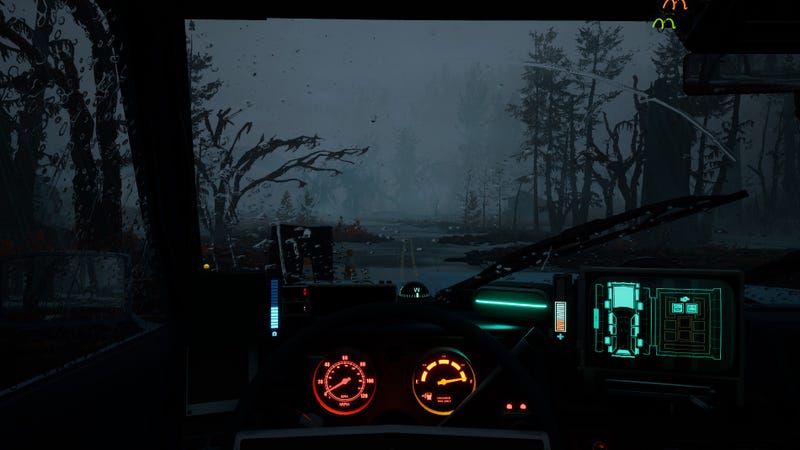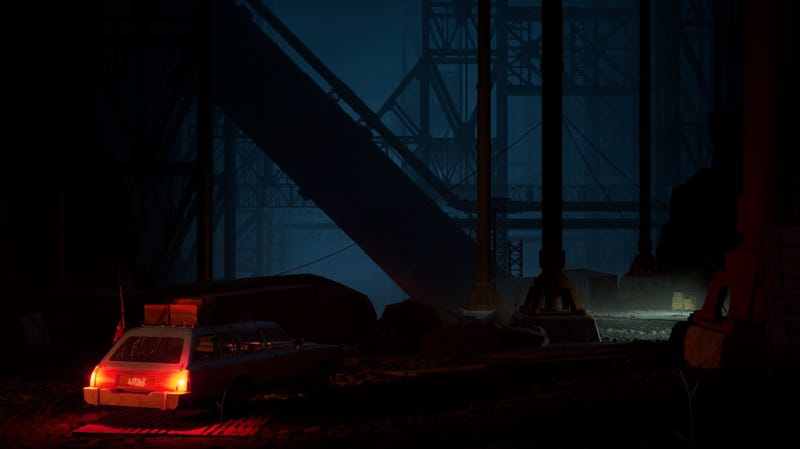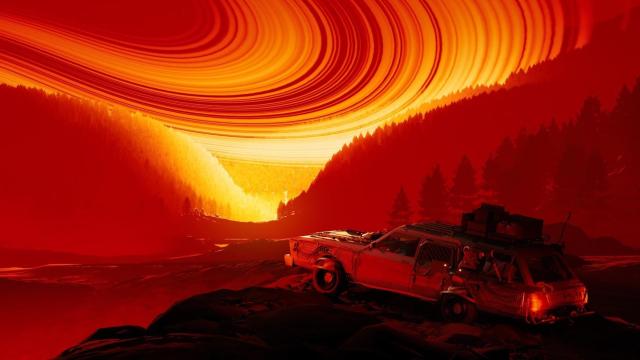I was lowkey terrified the first time I tried to start my station wagon in Pacific Drive. I turned on the ignition and listened to the old engine whir. It sputtered for a fraction of a second longer than I was expecting, reminding me of the dread I feel every time I put the key in my beat-up 2006 Toyota Rav4 wondering if it’s finally about to die on me. Eventually the virtual engine sprang to life and my adventure through the Tarkovsky-esque Olympic Exclusion Zone began, but the threat of analog failure remains pervasive throughout Pacific Drive’s early chapters. It’s part of the game’s background horror, as well as one of the key ways it builds a sense of emotional intimacy where you least expect it.
“I have an ‘89 Buick LeSabre and we did use that station wagon and I think at least one or two others when we were recording the different sounds for the car,” Ironwood Studios co-founder and creative director, Alex Dracott, told Kotaku in an interview prior to Pacific Drive’s February 22 release on PlayStation 5 and PC. Game director Seth Rosen added that there are systems in place to randomize the sounds and duration to create the illusion of unreliability. “My actual car does not like to start in the cold and so we made sure at least on one day to grab a full nice loop of it really not wanting to turn over,” Dracott said.
In Pacific Drive you explore an anomaly-filled section of the late ‘90s Pacific Northwest. Much of your time is taken up with scavenging for materials to fix and upgrade your station wagon, a mysterious relic in its own right, in order to get deeper into the Olympic Exclusion Zone so you can unravel its secrets and eventually escape it. The rest is spent in a garage that serves as a home base in-between missions, where you tinker with tires, duct tape, and welding materials as a haunting, eclectic mix of neofolk, alt-rock, and dream-pop plays on an old jukebox and your car radio. It’s an unlikely mashup of moody storytelling and systems management that makes Pacific Drive feel both recognizable and boldly original.

Generative AI not welcome
Given the randomized elements and procedurally generated levels in the game, Kotaku asked if Pacific Drive uses any generative AI tools. “As a company we have a pretty firm policy against using any of that stuff in really any capacity,” Rosen confirmed.
Despite the enigmatic worldbuilding and cryptic radio chatter from characters offscreen, the core of the adventure is a person and their car. Unlike most survival games where the player regulates their hunger, thirst, and gear to overcome danger, Pacific Drive puts you at the mercy of a “remnant” that takes the shape of a finicky 1970s jalopy, sort of like a ghost possessing a crossover between Back To the Future’s Delorean and Ghostbusters’ Ectomobile. Doors will break, bumpers will fall off, and tires will blow out, leading to scenarios where you feel like you’re just barely getting back to the safety of your garage by the skin of your teeth, hoping you collected enough junk on your journey to repair the damage done.
“We kind of tried to ride that line of making things not too annoying, but still lending them a physicality and giving you that fantasy of being a person who’s manually operating a vehicle without making it massively laborious to do so,” Rosen said. “It’s very much a sort of symbiotic relationship in that way where if you take care of [the car], it’ll take care of you.”

Early on you’re just getting used to manually managing parking brakes, windshield wipers, and a dashboard map of your surroundings. But a bevy of upgrades and car abilities completely changes how you navigate enemies and terrain later in the game. “It cuts a different silhouette,” Rosen said. “And it looks like way more of a machine for survival than something that’s kind of barely hanging together.”
Most games treat vehicles either as a bonus perk to save time or a purely instrumental means of getting around an expansive map. In Pacific Drive it’s the only thing that will keep you alive. Coming to terms with that dependency, and the risks associated with it, is a big part of what elevates each run through the Olympic Exclusion Zone into something more than just another tedious resource chase. Things go wrong. You struggle to adapt. Once back in the garage you breathe a sigh of relief before plunging yourself back into the work of fixing what’s broken and maybe even improving it.
Controlled chaos is what fuels combustion engines. Dracott and the rest of the development team compiled a spreadsheet of people’s horror stories with cars and everything that could go wrong with them. “When I was really young, I witnessed what happens when a tape deck catches fire,” he said. “It happened in my mom’s minivan and there’s a very, very strong memory of just how fast my mom got her kids out of the car.”

While cars can be notoriously unreliable, so can game development. In an era filled with sequels, knock offs, and retro homages, Ironwood Studios’ debut project feels both fresh and risky. (Dracott hasn’t tried surprise survival crafting hit Palworld yet and is instead prioritizing getting to last year’s Alan Wake II.) While it’s pulling on gameplay tropes from existing genres, “spooky car mechanic sim” is not necessarily an idea that pitches itself. And in a time when even small studios that ship ambitious and well-received games routinely go on to announce layoffs months later, Pacific Drive, despite marketing support from PlayStation and lots of buzz on Steam, seems like anything but a sure bet.
“It’s certainly intimidating, like, there’s no doubt about that,” Dracott said when asked about launching Ironwood Studios’ first game in the midst of an industry meltdown. “I think one of the things that I’ve been encouraged by is that as we’ve gone out–we’ve gone to PAX or we’ve had events for streamers–and they get their hands on the game and seeing the interest there align with the broader appeal that we see from the game has been very, very helpful.”
In a video game market that feels increasingly antagonistic to anything that dares to be weirder than it needs to be, Pacific Drive might be proof that there’s still room for more original experiments to succeed, not just creatively but commercially as well. “Folks didn’t necessarily know what to expect,” Rosen said. “But once they’re kind of getting to see the fullness of what it is and see how it kind of opens up over time and reveals itself to you, there’s a lot of excitement.”

Leave a Reply